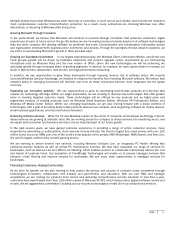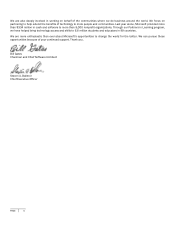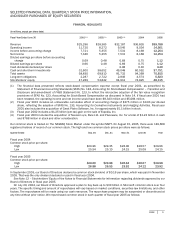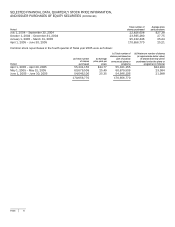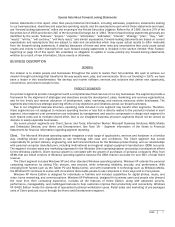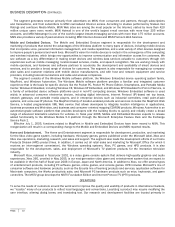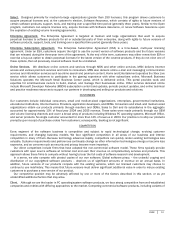Microsoft 2005 Annual Report Download - page 8
Download and view the complete annual report
Please find page 8 of the 2005 Microsoft annual report below. You can navigate through the pages in the report by either clicking on the pages listed below, or by using the keyword search tool below to find specific information within the annual report.
PAGE 7
Special Note About Forward-Looking Statements
Certain statements in this report, other than purely historical information, including estimates, projections, statements relating
to our business plans, objectives and expected operating results, and the assumptions upon which those statements are based,
are “forward-looking statements” within the meaning of the Private Securities Litigation Reform Act of 1995, Section 27A of the
Securities Act of 1933 and Section 21E of the Securities Exchange Act of 1934. These forward-looking statements generally are
identified by the words “believes,” “project,” “expects,” “anticipates,” “estimates,” “intends,” “strategy,” “plan,” “may,” “will,”
“would,” “will be,” “will continue,” “will likely result,” and similar expressions. Forward-looking statements are based on current
expectations and assumptions that are subject to risks and uncertainties which may cause actual results to differ materially
from the forward-looking statements. A detailed discussion of these and other risks and uncertainties that could cause actual
results and events to differ materially from such forward-looking statements is included in the section entitled “Risk Factors”
beginning on page 16 of this report. We undertake no obligation to update or revise publicly any forward-looking statements,
whether as a result of new information, future events or otherwise.
BUSINESS DESCRIPTION
GENERAL
Our mission is to enable people and businesses throughout the world to realize their full potential. We work to achieve our
mission through technology that transforms the way people work, play, and communicate. Since our founding in 1975, we have
been a leader in this transformation. We develop and market software, services and solutions that deliver new opportunity,
convenience, and value to people’s lives.
PRODUCT SEGMENTS
Our product segments provide management with a comprehensive financial view of our key businesses. The segments provide a
framework for the alignment of strategies and objectives across the development, sales, marketing, and services organizations,
and for the timely and rational allocation of development, sales, marketing, and services resources within businesses. The
segments also help focus strategic planning efforts on key objectives and initiatives across our broad businesses.
Due to our integrated business structure, operating costs included in one segment may benefit other segments. Therefore,
these segments are not designed to measure operating income or loss that is directly related to the products included in each
segment. Inter-segment cost commissions are estimated by management and used to compensate or charge each segment for
such shared costs and to motivate shared effort. Due to our integrated business structure, segments should not be viewed as
discrete or easily separable businesses.
Our seven product segments are: Client; Server and Tools; Information Worker; Microsoft Business Solutions; MSN; Mobile
and Embedded Devices; and Home and Entertainment. See Note 18 – Segment Information of the Notes to Financial
Statements for financial information regarding segment reporting.
Client. The Microsoft Windows operating system integrates a wide range of applications, services and hardware in a familiar
way, enabling people and organizations to use technology with ease and confidence. The Client segment has overall
responsibility for product delivery, engineering, and technical architecture for the Windows product family, and our relationships
with personal computer manufacturers, including multinational and regional original equipment manufacturer (OEM) accounts.
The segment includes sales and marketing expenses for the Windows Client operating system and product development efforts
for the Windows platform. Client revenue growth is correlated with the growth of purchases of personal computers (PCs) from
OEMs that pre-install versions of Windows operating systems because the OEM channel accounts for over 80% of total Client
revenue.
The Client segment includes Windows XP and other standard Windows operating systems. Windows XP extends the personal
computing experience by uniting PCs, devices, and services, while enhancing reliability, security, and performance. With
emerging form factors such as the Tablet PC and Media Center, and with investments in technology such as Windows Media,
the Windows PC continues to evolve with innovations that enable people to use computers in more ways and in more places.
Windows XP Home Edition is designed for individuals or families and includes capabilities for digital photos, music, and
video, home networking, and communications. Windows XP Professional, designed for business users and people who demand
the most from their computing experience, includes all the features of Home Edition, along with advanced security,
performance, manageability, and multilingual features to help customers improve their productivity and connectivity. Windows
XP 64-Bit Edition meets the demands of specialized technical workstation users. Retail sales and marketing of pre-packaged
units of Client products occurs through the Home and Entertainment segment.




